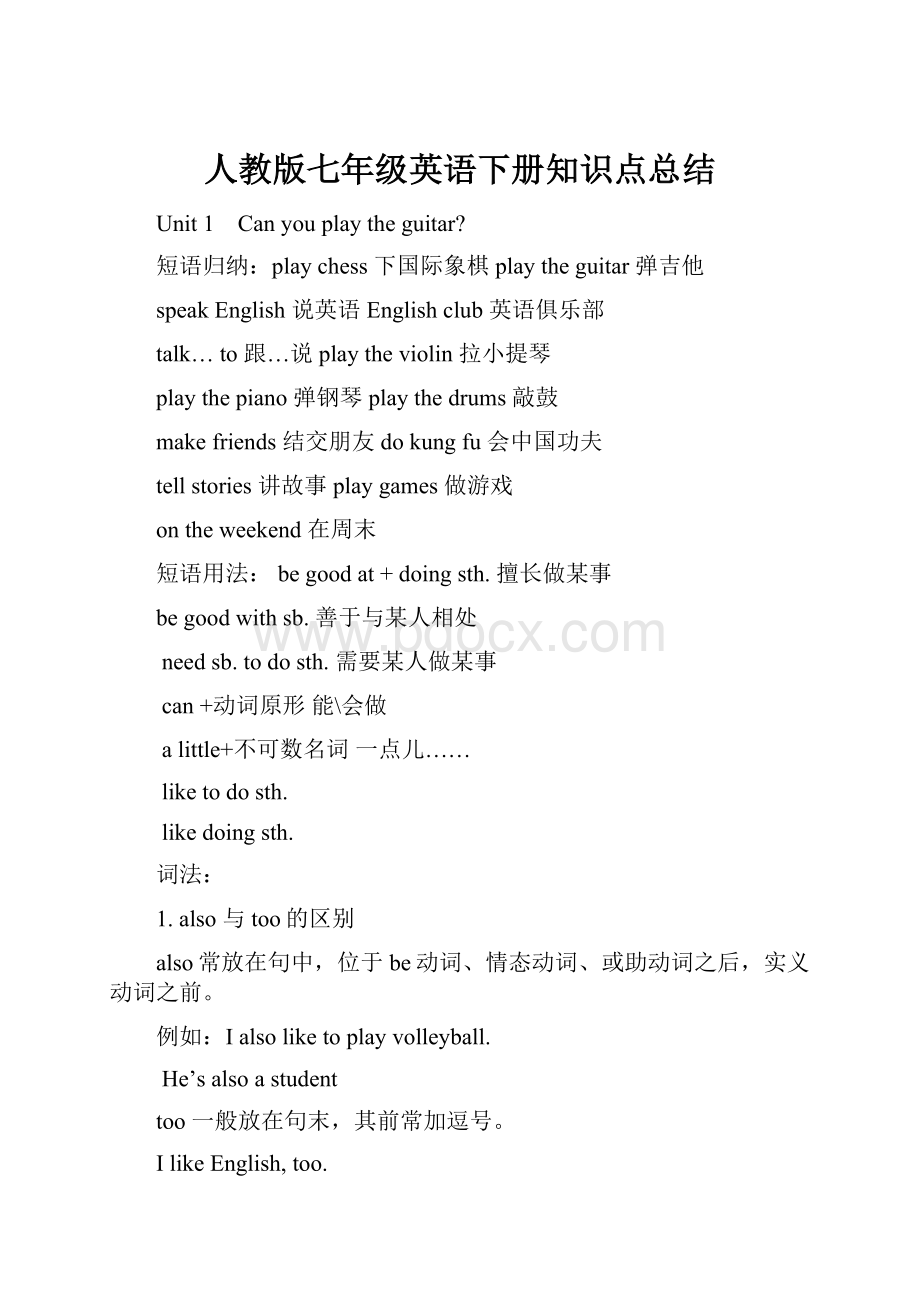人教版七年级英语下册知识点总结.docx
《人教版七年级英语下册知识点总结.docx》由会员分享,可在线阅读,更多相关《人教版七年级英语下册知识点总结.docx(41页珍藏版)》请在冰豆网上搜索。

人教版七年级英语下册知识点总结
Unit1 Canyouplaytheguitar?
短语归纳:
playchess下国际象棋playtheguitar弹吉他
speakEnglish说英语Englishclub英语俱乐部
talk…to跟…说playtheviolin拉小提琴
playthepiano弹钢琴playthedrums敲鼓
makefriends结交朋友dokungfu会中国功夫
tellstories讲故事playgames做游戏
ontheweekend在周末
短语用法:
begoodat+doingsth.擅长做某事
begoodwithsb.善于与某人相处
needsb.todosth.需要某人做某事
can+动词原形能\会做
alittle+不可数名词一点儿……
liketodosth.
likedoingsth.
词法:
1.also与too的区别
also常放在句中,位于be动词、情态动词、或助动词之后,实义动词之前。
例如:
Ialsoliketoplayvolleyball.
He’salsoastudent
too一般放在句末,其前常加逗号。
IlikeEnglish,too.
2.talk,say,speak,tell的用法
talk一般用作不及物动词,常与to,with连用,表示谈话。
say强调“说”的内容,常用作及物动词
speak后面一般接某种语言
tell告诉常用于tellsb.sth.
重点句子:
1.---Canyoudraw?
----Yes,Ican.\No,Ican’t
2.-----Whatclubdoyouwanttojoin?
------Iwanttojointhechessclub.
3.YoucanjointheEnglishclub.
4.Soundsgood.
5.IcanspeakEnglishandIcanalsoplaysoccer.
6.PleasecallMrs.Millerat555-3721
语法:
Ⅰ.情态动词
概念:
情态动词表示说话人对所说动作的观点。
如:
需要、可能、意愿、怀疑等。
意义:
情态动词一般有多个意义。
否定式:
情态动词的否定式一般为在其后加not。
一般疑问式:
一般疑问句通常将其提到句首。
Ⅱ.情态动词can的用法
A.意义
1.表示能力。
如:
HecanspeakEnglishverywell.他英语说得很好。
ShecansingsomeEnglishsongs.她会唱几首英文歌曲。
2.表示许可。
如:
Youcanplaytheviolinafterschooleveryday.
每天下课后你可以拉小提琴。
Studentscan‵ttakecellphonesorMp3playerstoschool.学生不允许带手机或MP3到学校。
3.表示请求。
如:
CanyoutellmeanEnglishstory?
你能给我讲个英语故事吗?
CouldyouhelpmewithmyEnglish?
你能帮我学英语吗?
温馨提示:
上句中的could是can的过去式,用在一般现在时的句子中,表示比can更客气的请求。
4.can't表示不可能。
如:
—IsthatMr.Smith?
那是史密斯先生吗?
—Thatcan'tbehim.HeisinNewYorknow.
那不可能是他。
他现在在纽约呢。
B.句型变化
肯定句:
Hecanplaythe_drums.
否定句:
He_________playthedrums.
一般疑问句:
_________he_________thedrums?
两种回答:
Yes,he_________./No,he_________.
对画线部分提问:
________________heplay?
Unit2 Whattimedoyougotoschool?
短语归纳:
whattime几点gotoschool去上学getup起床
takeashower洗淋浴brushteeth刷牙getto到达
dohomework做家庭作业gotowork去上班gohome回家
eatbreakfast吃早饭getdressed穿上衣服gethome到家
either…or…要么……要么……
inthemorning\afternoon\evening\在上午\下午\晚上
takeawalk散步lotsof许多radiostation广播电台
atnight在晚上belatefor迟到
词法:
at,in,on的用法
1.介词at常用于时刻前
介词in用在月份、季节、年份前,也可以表示在早上、在下午或在晚上。
介词on用在日期、星期几、节日前,也用来表示具体某一天的上午、下午或晚上.
2.Either…or…“要么……要么……”连接句子中两个并列的成分,表示两者之一。
连接两个主语时,谓语动词应与最近的一个主语在人称和数上保持一致,这就是我们常说的“就近原则”。
例:
EitheryouorIamgoingtheretomorrow.
重点句子
1.-----whattimedoyouusuallygetup?
-----Iusuallygetupatsixthirty.
2.That’safunnytimeforbreakfast!
那是个有趣的吃早饭的时间!
3.----whendostudentsusuallyeatdinner?
-----Theyusuallyeatdinnerataquartertosevenintheevening.
4.Herearetheclothes.这是你的衣服。
语法:
Ⅰ.一般现在时态特殊疑问句的结构
1.结构:
特殊疑问词+be+主语?
特殊疑问词+助动词do/does+主语+实义动词?
When/Whattimeistheparty?
Whendoyougotoschool?
Whattimedoeshegotowork?
常用的特殊疑问词:
when/whattime(什么时候),where(什么地方),who(谁),whose(谁的),how(如何)。
2.对画线部分提问:
(1)Theygetdressedat_six.
→________________________theygetdressed?
(2)Shetakesawalkat_nine.
→________________she_______awalk?
(3)Heusuallyswimsin_the_lake.
→________________he________?
(4)Jackgoestoschoolon_foot.
→________________Jack________toschool?
温馨提示:
whattime对具体某一时刻进行提问;when对笼统时间进行提问。
Ⅱ.英语时间表示法
1.使用数字( 点数+分钟数)。
如:
7:
20 seventwenty;8:
55 eightfiftyfive。
2.使用介词(past或to)。
当分钟数≤30分钟时,使用介词past,“分钟数+past+小时数”。
如:
9:
10 tenminutespastnine;10:
30 halfpastten;
当分钟数>30分钟时,使用介词to,“(60-分钟数)+to+(小时数+1)”。
如:
11:
40 twentyminutestotwelve.
温馨提示:
(1)特殊时间段的表示法:
30分钟可以使用half_代替;15
分钟可以使用quarter代替。
如:
5:
30halfpastfive;9:
45 aquartertoten。
(2)在某一时刻使用介词at。
(3)提问时间使用:
“Whattimeisit?
”或“What'sthetime?
”
Ⅲ.英语中的频度副词的用法
英语中常用的频度副词及含义:
always(总是;一直),usually(通常),never(从来没有),sometimes(有时)
候)等,常用在行为动词前。
如:
Iusuallytakeawalkafterdinner.
晚饭后我经常散步。
Henevergoestoschoollate.
他上学从不迟到。
Theysometimeseatlunchatschool.
他们有时候在学校吃午饭。
Ⅰ.单项选择
()1.—Eitheryouorshe________ondutytoday,
don'tforgetit.
—OK,Iwon't.
A.is B.am C.are D.be
()2.—Myparentsaskmetofinishmyhomework
________afterschool.
—It'sagoodhabit.
A.one B.first C.onesD.once
Ⅱ.用first,one,ones或once填空
1.Heisthe________intheEnglishtest.
2.—Pleasehaveanapple.
—Thanks,Ihave________.
3.Theseapplesaregreen,andthered________are
inthebasket.
4.Hecleanshiscar________aweek.
Ⅲ.用所给词的适当形式填空
1.EithersheorI________(be)busythisweek.
2.Neitheryounorhe________(be)atworknow.
3.There________(be)twobooksandapenonthedesk.
Ⅳ.同义句转换
Hehasajobintown.
Hehasapieceofworkintown.
Unit3 Howdoyougettoschool?
短语归纳:
gettoschool到达学校takethesubway乘地铁
rideabike骑自行车howfar多远
fromhometoschool从家到学校everyday每天
ridethebus乘公共汽车bybike骑自行车
busstop公共汽车站thinkof认为
between…and…在……和……之间one11-year-oldboy一个11岁的男孩
playwith…和…玩cometrue实现
haveto不得不
词法:
1.stoptodosth停下来去做某事
stopdoingsth停止正在做的事情
2.Itis+adj.+todosth做某事是……
Itiseasytorideabike.
Itisbettertostayathome.
重点句子:
1.----Howdoyougettoschool?
你是怎么去学校的?
-----Iridemybike.
2.Howfarisitfromyourhometoschool?
从你家到学校有多远?
3.Howlongdoesittakeyoutogettoschool?
你到学校花费多长时间?
4.Formanystudents,itiseasytogettoschool.
5.Thereisaverybigriverbetweentheirschoolandthevillage.
语法:
Ⅰ.how引导的一般现在时态的特殊疑问句
1.特殊疑问词how提问交通方式。
如:
—Howdoyougotoschool?
“你如何上学呢?
”
—Iridemybiketoschool.“我骑自行车去上学。
”
2.表达动作行为的方式,使用动词take(乘坐)、ride(乘车)、walk(步行)、fly(乘飞机)等;使用介词by等。
主语+take/ride/walk/fly+to+地点=主语+goto+地点+by+交通工具。
如:
(1)HetakestheplanetoBeijing.
=HeflytoBeijing.
=HegoestoBeijingbyplane.
(2)Shewalkstoschool.
=Shegoestoschoolonwalk.
Ⅱ.howfar与howlong的区别
howfar是提问两地之间的距离。
howlong用来提问做某个事物的要花的时间。
如:
Itisfivekilometersfrommyhometomyschool.(距离)
→______________isitfromyourhometoyourschool?
Theriveris1,000kilometerslong.(距离)
→______________istheriver?
Themeetingis2hours.(时间段)
→______________isthemeeting?
Ⅲ.hundred的两种用法
1.hundredsof+名词复数,“数以百记的,成百上千的”
2.数字+hundred+名词复数,“……百”。
如:
Therearehundredsofpeopleontheisland.
岛屿上有成百上千的人。
Hehasfivehundredinterestingbooks.
他有五百本有趣的书籍。
┃易错点针对训练┃
Ⅰ.单项选择
()1.Theislandisthebiggestone________islands.
A.amonghundredof
B.amongthreehundred
C.betweenhundredsof
D.betweenthreehundreds
()2.________takestheoldmanalongtime________
thedoorofhisown.
A.It;toopenB.It;opening
C.That;toopenD.That;opens
Ⅱ.用among或between填空
1.Intheword“map”,letter“a”stands________
letter“m”andletter“p”.
2.Look!
Thereisamanstanding________the
students.Heisourteacher.
Ⅲ.根据汉语提示完成句子
1.Hehas________________(两百本)storybooksat
home.
2.__________________(成百上千的)peopleare
relaxingonthesquareonhotsummernights.
Unit4 Don’teatinclass
短语归纳
ontime准时,按时listento听……inclass在课上
belatefor做……迟到haveto不得不bequiet安静
goout外出dothedishes清洗餐具makebreakfast做早饭
makeone’sbed铺床benoisy吵闹keepone’shairshort留短发
havefun玩得高兴makerules制定规则
短语用法
1.Don’t+动词原形+其他不要做某事
2.helpsb.(to)dosth.帮助某人做某事
3.toomany+可数名词复数太多的……
4.practicedoingsth.练习做某事
5.bestrictwithsb.对某人要求严格
6.bestrictinsth.对某事要求严格
7.learntodosth学会做某事
8.havetodosth.不得不做某事
词法
1.listen强调不及物动词,要加介词to,侧重于“听”的动作。
hear及物动词,强调“听”的结果
2.toomany,toomuch,muchtoo
toomany太多的,其后接可数名词的复数形式
toomuch太多的,后接不可数名词,还可以修是动词做状语
muchtoo太……后面接形容词或副词
3.read,look,see,watch
read通常指读书、看报、看信、看杂志等
look指有目的地“看”
see指“看见,看到”
watch一般指观看比赛,看电视等。
重点句子
1.Don’tarrivelateforclass.
2.Canwebringmusicplayerstoschool?
3.Therearetoomanyrules!
Ⅰ.祈使句
定义:
用于表达命令、请求、劝告、警告、禁止等的句子叫祈使句。
时态:
使用一般现在时态。
结构:
动词原形+其他成分+please.否定祈使句在动词原形前面加don’t。
如:
Bequietintheclassroom,please.
在教室里请保持安静。
Don'tfight.不要打架
Ⅱ.情态动词haveto和must
1.情态动词haveto和must都表示“必须”的意思。
haveto表示从客观条件上来看必须做某事;must表示说话人主观上必须要做某事。
如:
Thereisnobus,youhavetowalkhome.
(没有公交车是客观条件)
没有公共汽车,你必须走回家。
ImuststudyEnglishwell.(想学好英语是一种主观想法)
我必须要学好英语。
2.在否定结构中don'thaveto表示“不必”,而mustn't表示“禁止”。
如:
Youdon'thavetowaitforhim.你没必要等他。
Youmustn'tplaywithfire.It'sdangerous.
你禁止玩火。
那很危险。
【练习吧】
()1.—CanIgotothepark,Mum?
—Certainly.Butyou________bebackbeforesix
o'clock.
A.canB.mayC.mightD.must
()2.You________stopwhenthetrafficlightturns
red.
A.canB.haveto
C.needD.hadbetter
()3.________comelatetoschooltomorrow!
A.DoB.Does
C.BeD.Don't
┃易错点针对训练┃
Ⅰ.用wear,puton或dress填空
1.He____________hiscoatandgoesout.
2.Sheis____________aredskirttoday.
3.Thelittlechildcan________himselfnow.
Ⅱ.用toomany,toomuch或muchtoo填空
1.Thereare______________peopleand_____________
trafficinthestreet.It's______________crowded.
2.WatchingTV_______________isbadforourhealth.
Ⅲ.用too,also或either填空
1.HespeaksEnglish.Hecan________speakChinese.
2.IlikeMountTai.Helikesit,________.
3.Sheisn'tlate.Iamnotlate,________.
Ⅳ.用适当的介词填空
1.Iamafraidyoucan'tpass,becauseourbossisverystrict________thequalityofit.
2.Alltheworkerscan'tgooutatwork.Thebossarestrict________them.
Unit5 Whydoyoulikepandas?
短语归纳:
Kindof有几分,有点儿befrom\comefrom来自于
SouthAfrica南非allday整天foralongtime很长时间
getlost迷路cutdown砍倒
placeswithfoodandwater有食物和水的地方
in(great)danger处于极大危险之中
thingsmadeofivory由象牙制成的东西